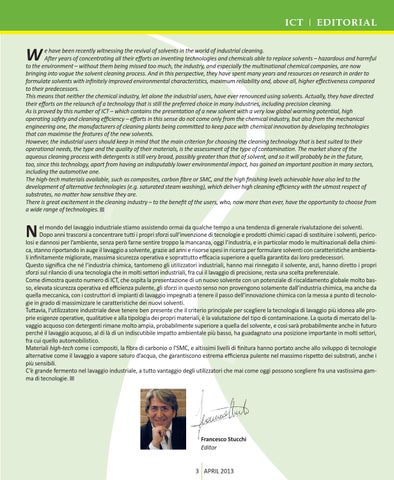ICT ICT HIGHLIGHT EDITORIAL
by Paola Giraldo
W
e have been recently witnessing the revival of solvents in the world of industrial cleaning. After years of concentrating all their efforts on inventing technologies and chemicals able to replace solvents – hazardous and harmful to the environment – without them being missed too much, the industry, and especially the multinational chemical companies, are now bringing into vogue the solvent cleaning process. And in this perspective, they have spent many years and resources on research in order to formulate solvents with infinitely improved environmental characteristics, maximum reliability and, above all, higher effectiveness compared to their predecessors. This means that neither the chemical industry, let alone the industrial users, have ever renounced using solvents. Actually, they have directed their efforts on the relaunch of a technology that is still the preferred choice in many industries, including precision cleaning. As is proved by this number of ICT – which contains the presentation of a new solvent with a very low global warming potential, high operating safety and cleaning efficiency – efforts in this sense do not come only from the chemical industry, but also from the mechanical engineering one, the manufacturers of cleaning plants being committed to keep pace with chemical innovation by developing technologies that can maximise the features of the new solvents. However, the industrial users should keep in mind that the main criterion for choosing the cleaning technology that is best suited to their operational needs, the type and the quality of their materials, is the assessment of the type of contamination. The market share of the aqueous cleaning process with detergents is still very broad, possibly greater than that of solvent, and so it will probably be in the future, too, since this technology, apart from having an indisputably lower environmental impact, has gained an important position in many sectors, including the automotive one. The high-tech materials available, such as composites, carbon fibre or SMC, and the high finishing levels achievable have also led to the development of alternative technologies (e.g. saturated steam washing), which deliver high cleaning efficiency with the utmost respect of substrates, no matter how sensitive they are. There is great excitement in the cleaning industry – to the benefit of the users, who, now more than ever, have the opportunity to choose from a wide range of technologies.
N
el mondo del lavaggio industriale stiamo assistendo ormai da qualche tempo a una tendenza di generale rivalutazione dei solventi. Dopo anni trascorsi a concentrare tutti i propri sforzi sull’invenzione di tecnologie e prodotti chimici capaci di sostituire i solventi, pericolosi e dannosi per l’ambiente, senza però farne sentire troppo la mancanza, oggi l’industria, e in particolar modo le multinazionali della chimica, stanno riportando in auge il lavaggio a solvente, grazie ad anni e risorse spesi in ricerca per formulare solventi con caratteristiche ambientali infinitamente migliorate, massima sicurezza operativa e soprattutto efficacia superiore a quella garantita dai loro predecessori. Questo significa che né l’industria chimica, tantomeno gli utilizzatori industriali, hanno mai rinnegato il solvente, anzi, hanno diretto i propri sforzi sul rilancio di una tecnologia che in molti settori industriali, fra cui il lavaggio di precisione, resta una scelta preferenziale. Come dimostra questo numero di ICT, che ospita la presentazione di un nuovo solvente con un potenziale di riscaldamento globale molto basso, elevata sicurezza operativa ed efficienza pulente, gli sforzi in questo senso non provengono solamente dall’industria chimica, ma anche da quella meccanica, con i costruttori di impianti di lavaggio impegnati a tenere il passo dell’innovazione chimica con la messa a punto di tecnologie in grado di massimizzare le caratteristiche dei nuovi solventi. Tuttavia, l’utilizzatore industriale deve tenere ben presente che il criterio principale per scegliere la tecnologia di lavaggio più idonea alle proprie esigenze operative, qualitative e alla tipologia dei propri materiali, è la valutazione del tipo di contaminazione. La quota di mercato del lavaggio acquoso con detergenti rimane molto ampia, probabilmente superiore a quella del solvente, e così sarà probabilmente anche in futuro perché il lavaggio acquoso, al di là di un indiscutibile impatto ambientale più basso, ha guadagnato una posizione importante in molti settori, fra cui quello automobilistico. Materiali high-tech come i compositi, la fibra di carbonio o l’SMC, e altissimi livelli di finitura hanno portato anche allo sviluppo di tecnologie alternative come il lavaggio a vapore saturo d’acqua, che garantiscono estrema efficienza pulente nel massimo rispetto dei substrati, anche i più sensibili. C’è grande fermento nel lavaggio industriale, a tutto vantaggio degli utilizzatori che mai come oggi possono scegliere fra una vastissima gamma di tecnologie.
Francesco Stucchi Editor
3 APRIL 2013
